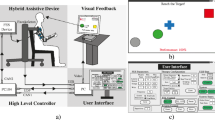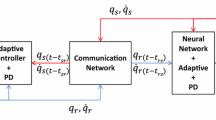Abstract
A three-dimensional stroke rehabilitation system is studied which combines the functional electrical stimulation (FES) with a robotic support to provide assistance to stroke patients who are required to perform upper extremity trajectory-tracking exercises with their residual voluntary efforts. When not enough voluntary efforts can be supplied, FES-based assistance is provided by applying electrical stimulation to the actuated muscles. In order to realize more rapid and accurate control of trajectory tracking, a new cascade control scheme is developed for the combined muscle and supported arm system. The stability of the cascade-controlled system and the internal stability of the unactuated dynamics are rigorously studied. The parameter optimal iterative learning control is then employed to further improve the trajectory-tracking accuracy of the cascade-based robotic system. Performance evaluation results confirm the effectiveness of the proposed method for upper arm trajectory-tracking-oriented stroke rehabilitation.












Similar content being viewed by others
References
Van der Putten, J.J.M.F., Hobart, J.C., Freeman, J.A., Thompson, A.J.: Measuring change in disability after inpatient rehabilitation: comparison of the responsiveness of the barthel index and the functional independence measure. J. Neurol. Neurosurg. Psychiatry 66, 480–484 (1999)
Hughes, A.M., Freeman, C., Burridge, J.H., Chappell, P.H., Lewin, P.L., Rogers, E.: Feasibility of iterative learning control mediated by functional electrical stimulation for reaching after stroke. Neurorehabil. Neural Repair 23, 559–568 (2009)
Hendricks, H.T., van Limbeek, J., Geurts, A.C., Zwarts, M.J.: Motor recovery after stroke: a systematic review of the literature. Arch. Phys. Med. Rehab. 83, 1629–1637 (2002)
National Audit Office: Reducing brain damage: faster access to better stroke care. HC 452 [Online]. http://www.nao.org.uk/publications/0506/reducing_brain_damage.aspx
Krebs, H.I., Palazzolo, J.J., Dipietro, L., Volpe, B.T., Hogan, N.: Rehabilitation robotics: performance-based progressive robot-assisted therapy. Auton. Robots. 15, 7–20 (2003)
Mohammad, M.F., Reza, B.: Impedance control of robots using voltage control strategy. Nonlinear Dyn. 74, 277–286 (2013)
Colombo, R., Pisano, F., Micera, S., Mazzone, A., Delconte, C., Carrozza, M.C., Dario, P., Minuco, G.: Assessing mechanisms of recovery during robot-aided neurorehabilitation of the upper extremity. Neurorehabil. Neural Repair 22, 494–504 (2002)
Freeman, C.T., Rogers, E., Hughes, A.M., Burridge, J.H., Meadmore, K.L.: Iterative learning control in health care: electrical stimulation and robotic-assisted upper-limb stroke rehabilitation. IEEE Control Syst. 32, 18–53 (2012)
de Kroon, J.R., van der Lee, J.H., Izerman, M.J., Lankhorst, G.J.: Therapeutic electrical stimulation to improve motor control and functional abilities of the upper extremity after stroke: a systematic review. Clin. Rehabil. 16, 350–360 (2002)
Burridge, J.H., Ladouceur, M.: Clinical and therapeutic applications of neuromuscular stimulation: a review of current use and speculation into future developments. Neuromodulation 4, 147–154 (2001)
Schmidt, R.A., Lee, T.D.: Motor Learning in Motor Control and Learning: A Behavioral Emphasis, Part 3. Human Kinetics, pp. 261–285. Human Kinetics Publishers, Champaign, IL (1999)
Rushton, D.N.: Functional electrical stimulation and rehabilitation—an hypothesis. Med. Eng. Phys. 25, 75–78 (2003)
Hunt, K.J., Munih, M., de Donaldson, N.: Feedback control of unsupported standing in paraplegia, part I: optimal control approach. IEEE Trans. Rehabil. Eng. 5, 331–340 (1997)
Previdi, F., Schauer, T., Savaresi, S.M., Hunt, K.J.: Data-driven control design for neuroprotheses: a virtual reference feedback tuning (VRFT) approach. IEEE Trans. Control Syst. Technol. 12, 176–182 (2004)
Watanabe, T., Iibuchi, K., Kurosawa, K., Hoshimiya, N.: A method of multichannel PID control of two-degree-of-freedom wrist joint movements by functional electrical stimulation. Syst. Comput. Jpn. 34, 319–328 (2003)
Zhang, D., Guan, T.H., Widjaja, F., Ang, W.T.: Functional electrical stimulation in rehabilitation engineering: a survey. In: 1st International Convention on Rehabilitation Engineering and Assistive Technology, Singapore (2007)
Baker, L.L., Mcneal, D.R., Benton, L.A., Bowman, B.R., Waters, R.L.: Neuromuscular Electrical Stimulation: A Practical Guide, 3rd edn. Rancho Los Amigos Medical Center, California, USA (1993)
Bristow, D.A., Tharayil, M., Alleyne, A.G.: A survey of iterative learning control: a learning based method for high-performance tracking. IEEE Control Syst. 26, 96–114 (2006)
Moore, K.L.: Iterative Learning Control for Deterministic Systems. Springer, Berlin (1992)
Freeman, C., Hughes, A.M., Burridge, J., Chappell, P., Lewin, P., Rogers, E.: Iterative learning control of FES applied to the upper extremity for rehabilitation. Control Eng. Pract. 17, 368–381 (2009)
Freeman, C., Lewin, P.L., Rogers, E.: Further results on the experimental evaluation of iterative learning control algorithms for non-minimum phase plants. Int. J. Control 80, 569–582 (2006)
Freeman, C., Tong, D., Meadmore, K., Hughes, A., Rogers, E., Burridge, J.: FES based rehabilitation of the upper limb using input/output linearization and ILC. In: American Control Conference, Montreal, pp. 27–29 (2012)
Xu, W.K., Chu, B., Rogers, E.: Cascade based iterative learning control of robotic-assisted upper extremity stroke rehabilitation. In: IEEE International Conference on Decision and Control, Florance, pp. 6688–6693 (2013)
Xu, W., Chu, B., Rogers, E.: Iterative learning control for robotic-assisted upper limb stroke rehabilitation in the presence of muscle fatigue. Control Eng. Pract. 31, 63–72 (2014)
Spong, M.W., Hutchinson, S., Vidyasagar, M.: Robot Dynamics and Control. Wiley, New York (2004)
Slotine, J.J., Li, W.P.: Applied Nonlinear Control. Prentice Hall, New Jersey (1991)
Lum, P.S., Burgar, C.G., Shor, P.C.: Evidence for improved muscle activation patterns after retraining of reaching movements with the MIME robotic system in subjects with post-stroke hemiparesis. IEEE Trans. Neural Syst. Rehabil. Eng. 12, 186–194 (2004)
Baratta, R., Solomonow, M.: The dynamic response model of nine different skeletal muscles. IEEE Trans. Biomed. Eng. 37, 243–251 (1990)
Le, F., Markovsky, I., Freeman, C.T., Rogers, E.: Identification of electrically stimulated muscle models of stroke patients. Control Eng. Pract. 18, 396–407 (2010)
Freeman, C., Tong, D., Meadmore, K., Cai, Z., Rogers, E., Hughes, A.M., Burridge, J.H.: Phase-lead iterative learning control algorithms for functional electrical stimulation based stroke rehabilitation. Proc. Inst. Mech. Eng. Part I J. Syst. Control Eng 225, 850–859 (2011)
Sage, H.G., De Mathelin, M.F., Ostertag, E.: Robust control of robot manipulators: a survey. Int. J. Control 72, 1498–1522 (1999)
Mohammad, M.F.: Nonlinear control of electrical flexible-joint robots. Nonlinear Dyn. 67, 2549–2559 (2012)
Mohammad, R.S., Mohammad, H.K.: A particle swarm optimization approach for fuzzy sliding mode control for tracking the robot manipulator. Nonlinear Dyn. 74, 467–478 (2013)
Xu, W.K., Cai, C.X., Zou, Y.: Neural-network-based robot time-varying force control with uncertain manipulator-environment system. Trans. Inst. Meas. Control (2014). doi:10.1177/0142331214528971. http://tim.sagepub.com/content/early/2014/04/17/0142331214528971.full.pdf+html
Hassan, K.K.: Nonlinear systems. Prentice Hall, New Jersey (2002)
Isidori, A.: Nonlinear Control Systems. Springer, Berlin (1989)
Owens, D.H., Hatonen, J.J., Daley, S.: Robust monotone gradient-based discrete-time iterative learning control. Int. J. Robust Nonlinear Control 19, 634–661 (2009)
Owens, D.H., Hatonen, J.J.: Iterative learning control and optimization paradigm. Annu. Rev. Control 29, 57–70 (2005)
Meadmore, K.L., Hughes, A.M., Freeman, C., Cai, Z., Tong, D., Burridge, J.H., Rogers, E.: Functional electrical stimulation mediated by iterative learning control and 3D robotics reduces motor impairment in chronic stroke. J. Neuroeng. Rehabil. 9, 32 (2012)
Acknowledgments
The authors are grateful to the handling editor and reviewers for their valuable comments and suggestions. Prof. Eric Rogers, Dr. Chu Bing and Dr. Christopher Freeman at University of Southampton are highly appreciated for their stimulating discussions and judicious suggestions.
Author information
Authors and Affiliations
Corresponding author
Additional information
The work has been supported by the National Natural Science Foundation of China under Grant Nos. 61174038, 61104064, 61170054 and Fundamental Research Funds for the Central Universities under Grant No. 30920140112005.
This article has been retracted by the Editor-in-Chief of Nonlinear Dynamics. The stability analysis, which comprises the three-page entirety of Section 4, is an equation-by-equation copy, included without credit or citation, of Section III.C of the paper "Freeman, Christopher, Tong, Daisy, Meadmore, Katie, Hughes, Ann-Marie, Rogers, Eric and Burridge, Jane (2012) FES based Rehabilitation of the Upper Limb using Input/Output Linearization and ILC. In, 2012 American Control Conference, Montréal, 27 - 29 Jun 2012. pp 4825-4830
About this article
Cite this article
Xu, W., Cai, C. & Zou, Y. RETRACTED ARTICLE: Cascade controller design and stability analysis in FES-aided upper arm stroke rehabilitation robotic system. Nonlinear Dyn 79, 1099–1114 (2015). https://doi.org/10.1007/s11071-014-1726-1
Received:
Accepted:
Published:
Issue Date:
DOI: https://doi.org/10.1007/s11071-014-1726-1




